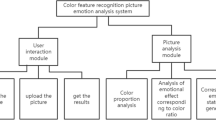Abstract
This research uses an innovative way to detect and recognize user’s emotion with RGB color system. The RGB color system that is widely used in diverse computer system is an additive color model in which red, green, and blue light are added together showing various color. This study was based on Thayer’s emotion model which describes the emotion with two vectors, valence and arousal, and gathers the emotion color with RGB as input of neural network for calculating and forecasting user’s emotion. In this experiment, using 320 data translate to quarter into emotion groups to train the weight in the neural network and uses 160 data to proof the accuracy. The result reveals that this model can be valid estimated the emotion by reply color response from examinee. In other hand, this experiment found that trend of the different element of color on Cartesian coordinate system figures out the distinguishing intensity in RGB color system. Via the foregoing detect emotion model is going to design an affective computing intelligence framework try to embed the emotion component in it.
Access this chapter
Tax calculation will be finalised at checkout
Purchases are for personal use only
Similar content being viewed by others
References
Kosko B (1986) Fuzzy cognitive maps. Int J Man Mach Stud 24:65–75
Stach W, Kurgan L, Pedrycz W (2010) A divide and conquer method for learning large fuzzy cognitive maps. Fuzzy Sets Syst 161:2515–2532
Picard RW (2000) Affective computing: MIT press, Cambridge
Cheng BHC, De Lemos R, Giese H, Inverardi P, Magee J (2009) Software engineering for self-adaptive systems. Springer, Berlin, pp 48–70
Thayer RE (1989) The biopsychology of mood and arousal. Oxford University Press, Oxford
Jaques PA, Vicari RM (2007) A BDI approach to infer student’s emotions in an intelligent learning environment. Comput Educ 49:360–384
Damasio A (2008) Descartes’ error: emotion, reason and the human brain. Random House, New York
Izard CE (1984) Emotion-cognition relationships and human development. Emotions Cogn Behav, pp 17–37
Goleman D (2006) Emotional intelligence: why it can matter more than IQ. Random House Digital Inc, New York
Minsky M (1889) The society of mind. 1988. Simon & Schuser, NY
Minsky M (2007) The emotion machine: commonsense thinking, artificial intelligence, and the future of the human mind. SimonandSchuster. com
Tao J, Tan T (2005) Affective computing: a review. In: Affective computing and intelligent interaction. Springer, Berlin, pp 981–995
Rezazadeh IM, Wang X, Firoozabadi M, Hashemi Golpayegani MR (2011) Using affective human–machine interface to increase the operation performance in virtual construction crane training system: a novel approach. Autom Constr 20:289–298
D’Mello S, Chipman P, Graesser A (2007) Posture as a predictor of learner’s affective engagement. In: Proceedings of the 29th annual cognitive science society, pp 905–910
Kapoor A, Burleson W, Picard RW (2007) Automatic prediction of frustration. Int J Hum Comput Stud 65:724–736
Pantic M, Rothkrantz LJ (2003) Toward an affect-sensitive multimodal human-computer interaction. Proc IEEE 91:1370–1390
Castellano G, Villalba SD, Camurri A (2007) Recognising human emotions from body movement and gesture dynamics. In: Affective computing and intelligent interaction. Springer, Berlin, pp 71–82
Grimm M, Kroschel K, Harris H, Nass C, Schuller B, Rigoll G, Moosmayr T (2007) On the necessity and feasibility of detecting a driver’s emotional state while driving. In: Affective computing and intelligent interaction. Springer, Berlin, pp 126–138
Wagner J, Vogt T, André E (2007) A systematic comparison of different HMM designs for emotion recognition from acted and spontaneous speech. In: Affective computing and intelligent interaction. Springer, Berlin, pp 114–125
Komatsu T, Ueda K, Komeda T (2007) Comprehension of users’ subjective interaction states during their interaction with an artificial agent by means of heart rate variability index. In: Affective computing and intelligent interaction. Springer, Berlin, pp 266–277
Holden R, Rubery J (2013) Emotion. In: Pearsall J (ed) Oxford dictionaries. Oxford University Press, Oxford
Pittman RE, Taxonomy of learning. PediaPress, Germany
Ellsworth PC (1994) William James and emotion: is a century of fame worth a century of misunderstanding? Psychol Rev 101:222
Hofmann M, Beaumont LR (2005) Content networking: architecture, protocols, and practice. Elsevier, pp 179–216
Ekman P (2000) In: Dalgleish T, Power M (eds) Handbook of cognition and emotion. Wiley, pp 45–60
Ekman P (2000) In: Dalgleish T, Power M (eds) Handbook of cognition and emotion. Wiley, pp 51–53
Russell JA (1980) A circumplex model of affect. J Pers Soc Psychol 39:1161–1178
Acampora G, Loia V, Vitiello A (2011) Distributing emotional services in ambient intelligence through cognitive agents. SOCA 5:17–35
Yang Y-H, Lin Y-C, Su Y-F, Chen HH (2007) Music emotion classification: a regression approach. In: IEEE international conference on multimedia and expo, 2007, pp 208–211
Nielsen RH (1990) Neurocomputing. Addison-Wesley, Reading
Author information
Authors and Affiliations
Corresponding author
Editor information
Editors and Affiliations
Rights and permissions
Copyright information
© 2014 Springer Science+Business Media Dordrecht
About this paper
Cite this paper
Lee, MF., Chen, GS., Wang, JC. (2014). Using Affective Computing to Detect Emotions with Color. In: Park, J., Zomaya, A., Jeong, HY., Obaidat, M. (eds) Frontier and Innovation in Future Computing and Communications. Lecture Notes in Electrical Engineering, vol 301. Springer, Dordrecht. https://doi.org/10.1007/978-94-017-8798-7_41
Download citation
DOI: https://doi.org/10.1007/978-94-017-8798-7_41
Published:
Publisher Name: Springer, Dordrecht
Print ISBN: 978-94-017-8797-0
Online ISBN: 978-94-017-8798-7
eBook Packages: EngineeringEngineering (R0)




